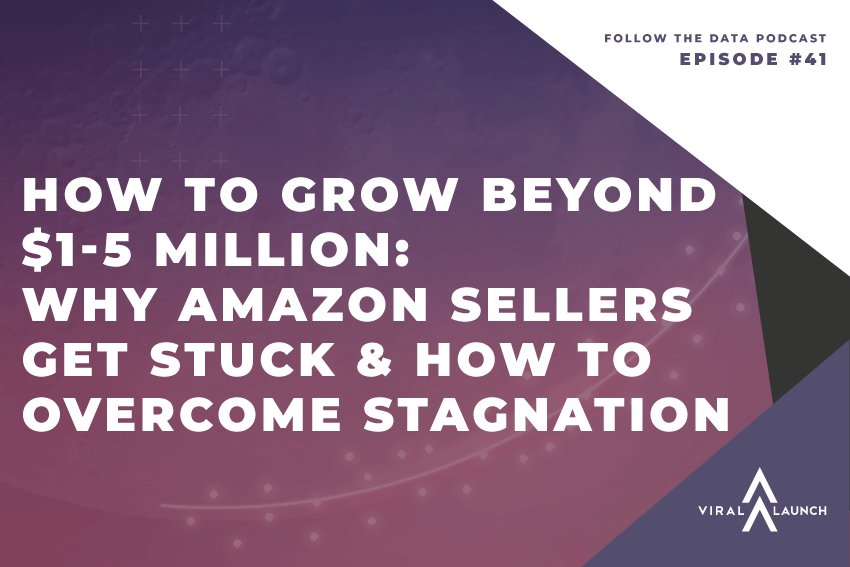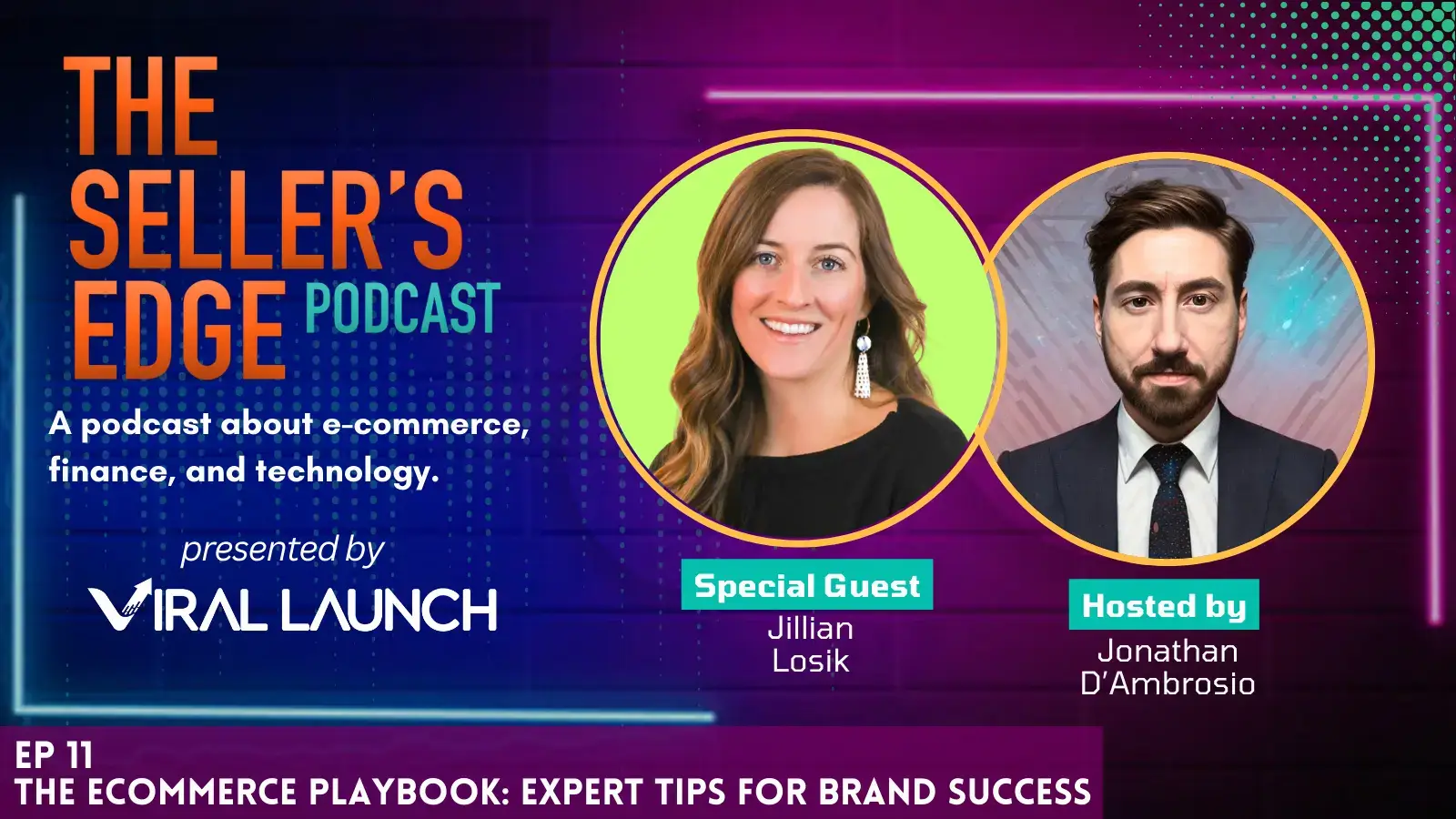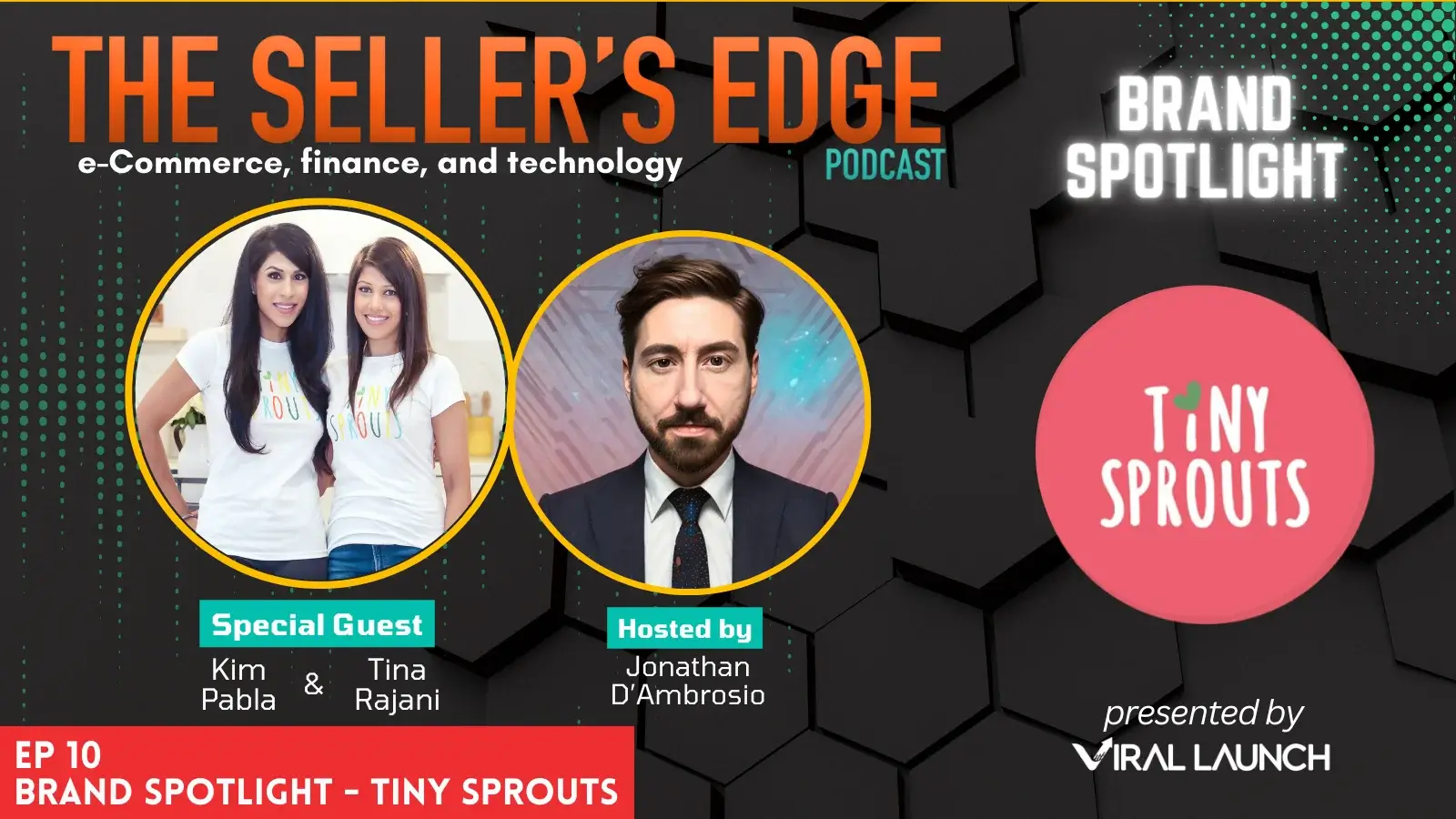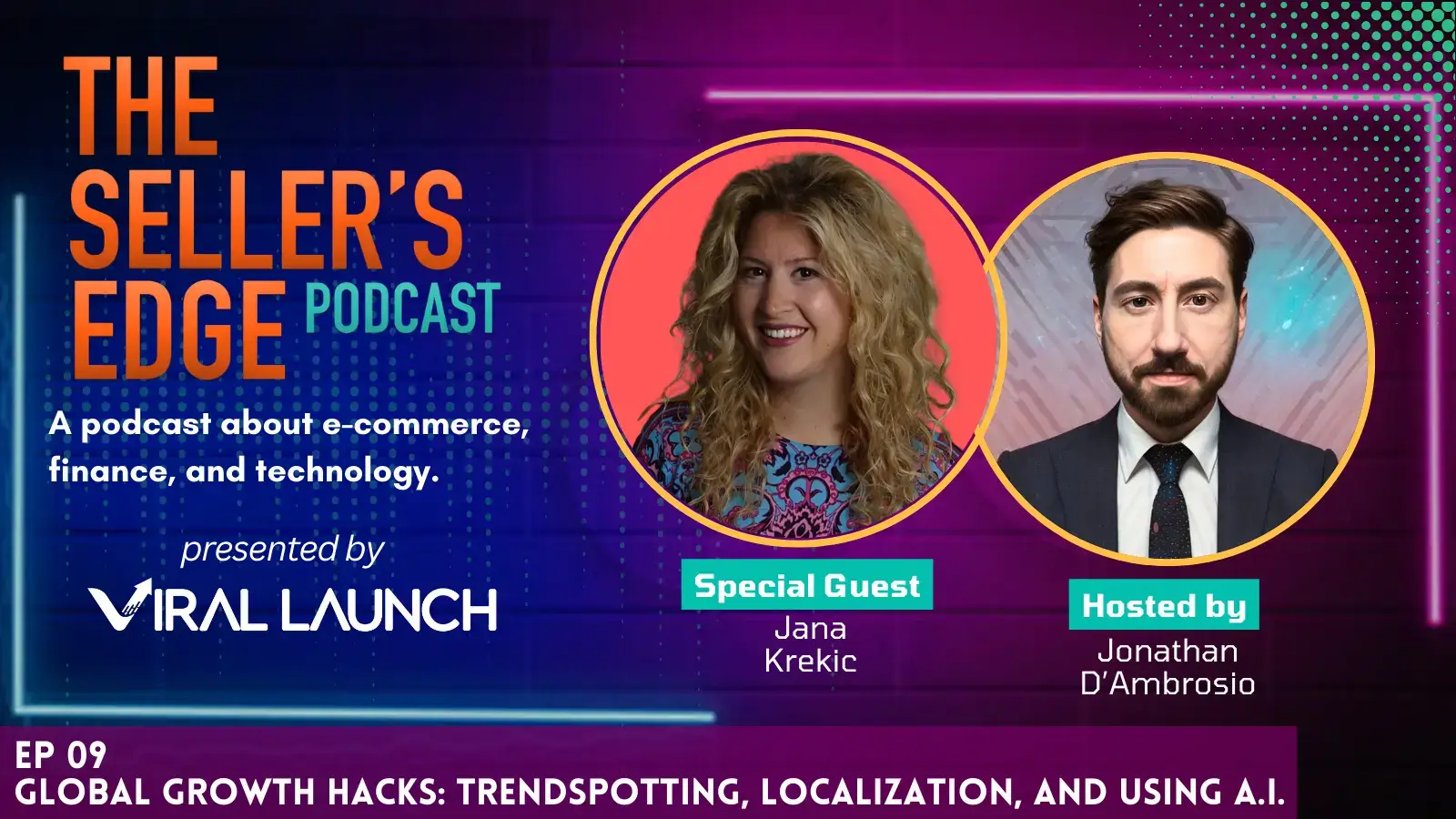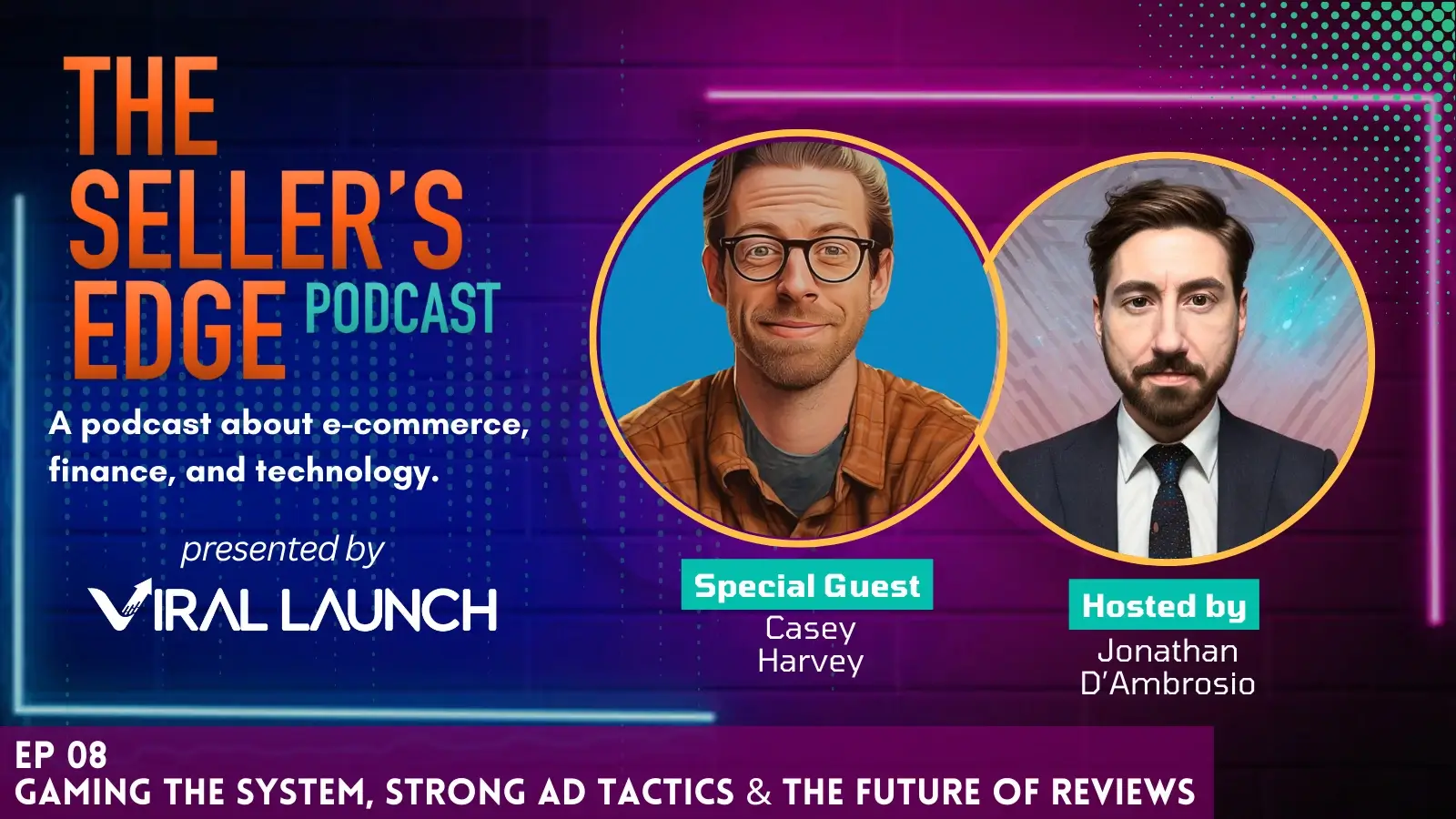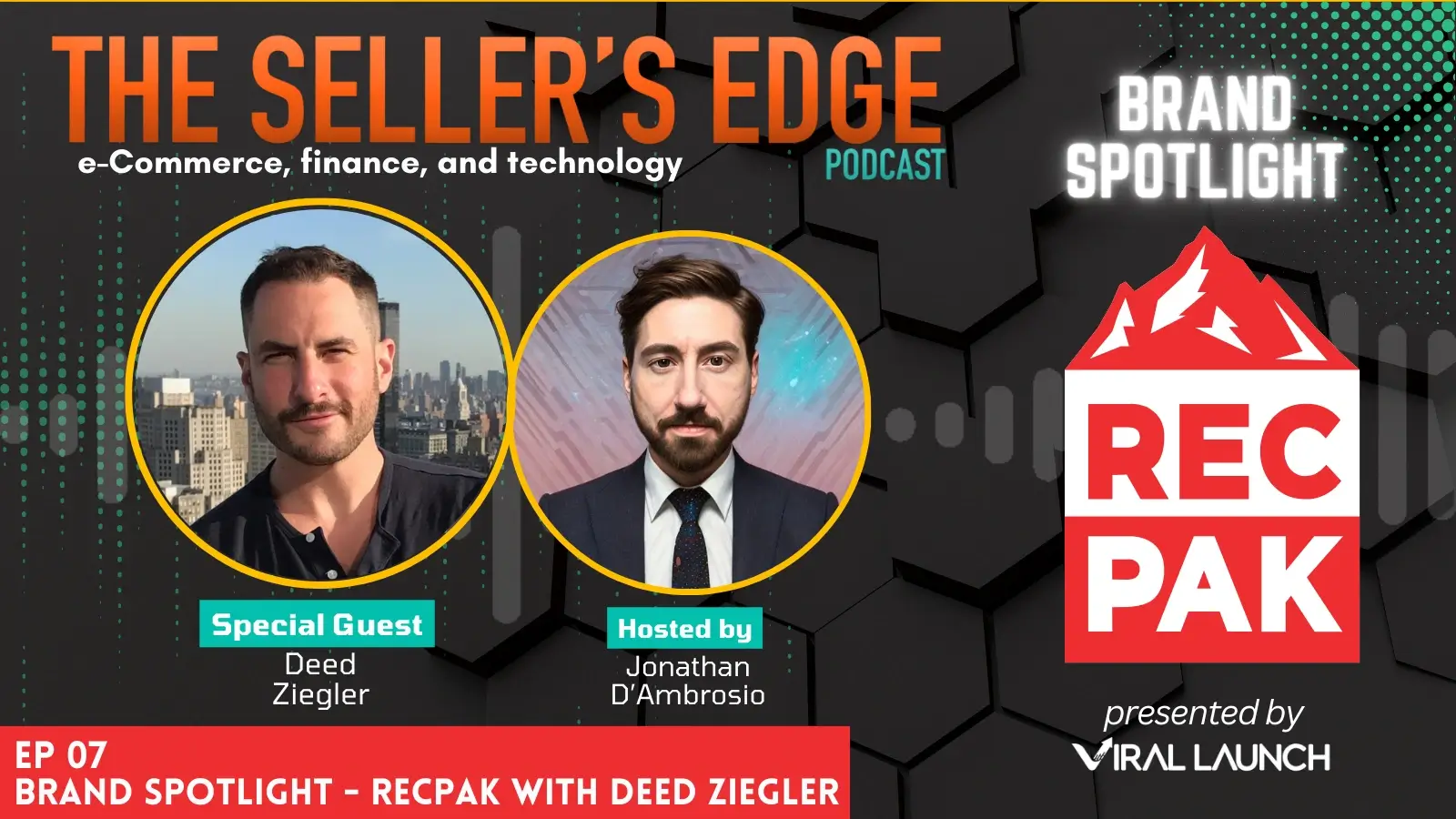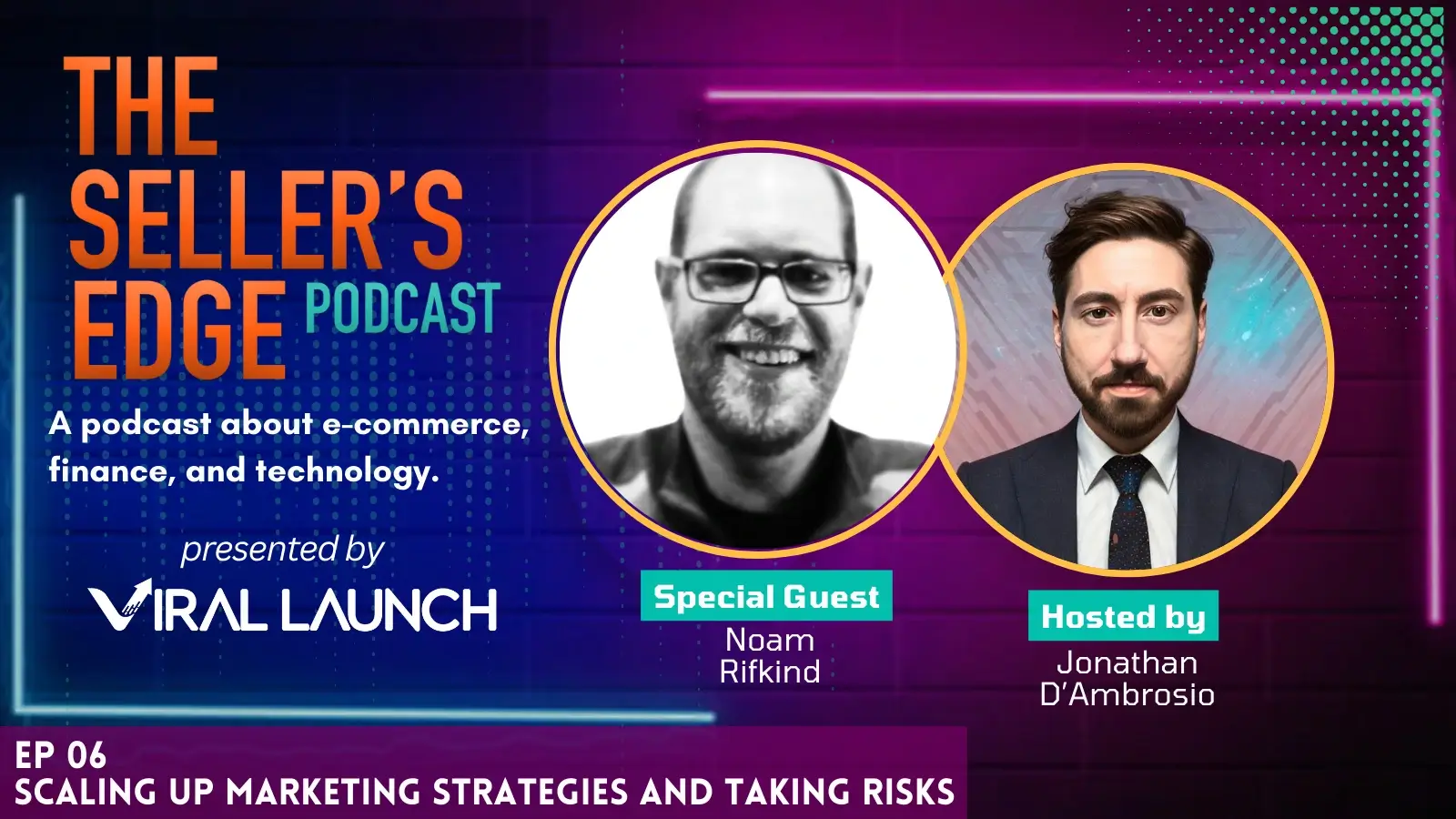How To Grow Beyond $1-5 Million: Why Amazon Sellers Get Stuck & How To Overcome Stagnation
Every success comes with a series of challenges; roadblocks along the way to test your resolve – to test whether you can progress to the next level of sales, or stay where you’ve been. We’ve been able to accumulate a LOT of data here at Viral Launch. We’ve also had the opportunity to see LARGE sellers scale successfully, AND see the same sellers struggle to progress past $1-5million in revenue. In this episode, we break down why sellers are getting stuck – why they AREN’T progressing. We’ll outline the problems causing stagnation, and solutions to make sure you can keep on growing your business.
Listen on iTunes Listen on Stitcher
TRANSCRIPT:
CAMERON YODER:
Every success comes with a series of challenges, roadblocks along the way to test your resolve, to test whether you can progress to the next level of sales or stay where you’ve been.
CASEY GAUSS:
We’ve been able to accumulate a lot of data here at Viral Launch. We’ve also had the opportunity to see large sellers scale successfully and see the same sellers struggle to progress past the $1 million to $5 million mark. I’m Casey Gauss.
CAMERON YODER:
And I’m Cameron Yoder, your hosts for Follow the Data: Your Journey to Amazon FBA Success. In this show we leverage the data we’ve accumulated at Viral Launch from over 35,000 product launches and our experience working with more than 10,000 brands to help you understand the big picture when it comes to Amazon and the best practices for success as an Amazon seller.
CASEY GAUSS:
In this episode Cam and I break down why sellers are getting stuck, why they aren’t progressing. We’ll outline the problems causing stagnation and solutions to make sure you can keep on growing your business. Let’s dive in.
CAMERON YODER:
All right, we’re talking about getting stuck and pushing past the stuck, and to specifically stuck at around the $1 million to $5 million mark. That’s a pretty big dollar amount.
CASEY GAUSS:
Yeah, so if you see me talk at conferences you’ve probably seen me talk on this subject. This is something that I’m particularly passionate about because it is so strange that so many people literally get stuck in this same revenue threshold or phase of your Amazon business, and I just really want to help people get past that point. We’ve seen people get stuck in this point and then get past it. We’ve seen people get stuck in this point and not get past it. And so I’m really hoping that we can share the tactics that these guys used, or what is the common factors of the people that went far past that.
And just to give a little bit of context, you know I have a lot of friends that are doing the 10, 20, 30, 40, $100 million on Amazon. So some of my good friends are doing well over $100 million. They have essentially four brands that are doing this, so these are very high-volume brands. I have another friend that did $80 million last year. They came to us in 2015. They were doing, I think, $40 million at that time. So we’ve helped them double their business, and this year they’re already on track to do $100 million, which is amazing. But you know, there’s definitely like some fundamental differences between these guys that are just having this meteoric rise and the people that have that meteoric rise until they get to the $1 million to $5 million mark. And so maybe you’re happy at the $1 million to $5 million mark. Maybe you don’t care to push past that. But a lot of people do, and a lot of people get frustrated with themselves. They start to kind of question their abilities maybe as entrepreneurs, or you know, there’s just a lot of frustration in this phase. And so I just want to help use the data, the experience that we have in walking people through this and watching people walk through this to help make sure that you don’t get stuck there. And even if you’re not at the $1 million to $5 million mark some of these principles can help you get there, and also you will be more confident that when you get to this mark you’ll be able to just cruise right on pass it to the $10 million mark, the $20 million mark and so on.
CAMERON YODER:
We are at a really good position, in a good position to aggregate a lot of data. Like again, we’ve talked about before if you’ve listened to the podcast before, you know that we’re all about the data, Follow the Data, everything like that. But it’s really cool for us to be in a spot where we can talk with all of these high-level sellers and know these sellers, and know what they’ve been through and see the roadblocks that they experience to be able to aggregate data kind of in a different way. It really is – it’s data from a seller’s perspective. It’s data from a seller’s experience, so it’s not necessarily numbers. Or it does involve numbers, but it also involves experience and everything in between. So like Casey said, even if you’re not at the $1 million to $5 million mark, there is still a lot here that applies to sellers in general.
CASEY GAUSS:
Yep. And again, in terms of data, you know it may be one seller’s experience that they were able to get past the $1 million to $5 million mark, and that may not necessarily be a good fit for you. And so the advantage that we have is just we’ve seen so many instances of X, and so then we’re able to describe X from this vantage point of seeing different people walk through it in different ways.
CAMERON YODER:
All right, Casey, what is one of the top reasons that these sellers cannot push past that $1 million to $5 million mark?
CASEY GAUSS:
Yeah, so reason number one is because sellers are becoming the bottleneck to their business. And so you know, I have a friend. Very quickly he went from zero to $500,000 a month, very, very quickly. I think it took him about six months to do that. And this guy was absolutely killing it, and I ended up talking to him like 9 to 12 months later, and he was still, you know, he was maybe doing $600,000 a month at that time, but there was very little growth. And he even admitted to the fact that he was struggling to grow because he was the bottleneck. Like he was managing his own PPC. He was doing literally like everything maybe outside of like customer support and stuff like that.
And so he – and the reason – so I asked him, well why don’t you build a team? Like you need to get other people in the team so that they can handle these things so that you can focus on the really high-growth levers. And he said he has such a hard time doing that because he’s a perfectionist, and he knows that people will not do it as well as himself. And I hear this excuse all the time. And I totally get it. So I have a little bit of experience in that. You know, we have 47 employees now here at Viral Launch. And so I understand that, but the way that you have to look at it is, you know, look at Mark Zuckerberg, right? Mark Zuckerberg, probably a great programmer, and Mark Zuckerberg isn’t coding. He hired people that are probably a lot better coders than himself, and even if not he understands that if he wants to build Facebook he can’t sit there and write code every day. He needs to be a CEO. And I want to encourage you to get in that CEO mindset. If you are amazing at PPC, maybe that’s one of the last things that you outsource, but you need – there are so many things that you are doing that you probably shouldn’t be doing.
So if you look at things – let’s use some data. So if you look at things from an opportunity cost perspective, so let’s say you’re a $1 million seller, which equates to, just for simple math, you know, $80,000 per month, and there is around 168 business hours per month. That’s like 40 hours per week, let’s say. So if you divide that $80,000 per month by 160 hours, that’s approximately $500 an hour that you’re making. And so that means that whatever you are doing is worth $500 per hour, assuming that you work just business hours. Most of us don’t, but whatever. So anyways, for the sake of the example bear with me. So basically what that means is if there are things that you are doing that you cannot outsource for less than $500 an hour, you should be doing those. But if you can find someone to do these particular tasks, whether it is talking with suppliers to make sure that you’re getting samples, or whatever. So if you can find someone to do that for less than $500 an hour you’re making more money by doing that so that you can focus on the higher-level issues.
And so this should – I think it’s obviously harder to apply, but anyways this is just one quick example of if you’re a $1 million seller, even if you’re half that, if you’re making basically $250 per work hour, you can hire people. You should not be hiring anybody that is even close to $250 an hour. That means almost everything you should be outsourcing. My friends who are doing $100 million, the only way that they got there was they had a team in place that is doing everything from going and checking – let’s say you weren’t using software. So they’re going and they’re checking to see, okay, is the product ranking? Do we still have the bestseller badge? How are our competitors doing? How are our sales today? How are our sales this hour? How is PPC? Like, one, you should be using tools to monitor these things for you so you’re not wasting all this time.
Again, if your time is worth $500 an hour and there’s a software that does it for $40 per month, oh my gosh, like come on. I know that it’s easy to want to save money, but if you think about it from an opportunity cost standpoint you need to do things to get to that $2 million mark, to that $3 million mark, to that $10 million mark. And the only way that you can do that is by focusing on the high-value things. So if you’re spending half of your day going and looking at metrics, going and making sure that your reviews are still good, that you don’t have like bad reviews getting upvoted, all these things. There are tools that can monitor these things for you, or at the very least maybe you don’t trust the tools for whatever reason. You can hire someone at $5 an hour, $10 an hour to go monitor these things for you, and now you’re paying $20 bucks a day or whatever, and you’re still getting it done. And I know that’s $20 a day that’s going out the door, but theoretically now you’re able to focus on the super high-value things, which is maybe new product selection, expanding your brand, like these things that really matter, focusing on getting keyword ranking, or figuring out some method of driving reviews at a better rate. These are the things that are really, really making your business grow. And yes, you obviously need to understand how the metrics are performing and stuff.
Anyways, long rant to say you absolutely cannot grow to whatever you aspire to or – I hope you have big dreams. You can’t grow to whatever you aspire to without hiring people. And you know, here at Viral Launch I try to hire people that are better than me at everything, essentially. And if they’re not better than me, then we’re probably working together, and they’re better at some aspects of that.
So my favorite thing is product. We hired a Director of Product, and while she is great at coming up with ideas, she comes up with a lot of ideas and then we just work together to prioritize them and make sure that we go with the best ideas at the best time. But she’s so much better at organization, execution, and so she’s focused on those things. And whatever you’re best at, maybe it’s PPC, or maybe it is in product selection. At first maybe don’t outsource those things, and then what you end up doing is you hire someone that is pretty good at PPC that you can coach through. You can show them your process, and as long as you’re doing a good job as a manager, as a leader, like you don’t necessarily have to have these fears that they’re just going to take all your information and run. And even if they did, like they’re going to work for you for some period. Like I think your worst-case scenario is not nearly as bad as you think, and your worst-case scenario is probably not nearly as bad as you getting stuck at that $1 million mark.
CAMERON YODER:
I think a lot of high-level sellers have a lot of trouble getting over the thought that, getting over the thought of failure. Like the question comes into their mind. There’s failure and ego. So why – the question is why would I bring somebody on that is going to fail? And I think you, as a high-level seller, need to accept the fact that you will fail and that your team is going to fail at some point in time. Like you will experience failure. If you haven’t yet, go listen to our failure episode of our podcast because we talk about failure in that. But you as a seller, you need to realize that in order to get over that $1 million to $5 million mark, or even to get to that spot as well, you need to outsource, and that when you’re going to outsource jobs, or statistics, or whatever you’re doing, any job, then that person is going to fail. You have to accept that. You have to be okay with that. If you just going to do everything yourself, again, you’re not going to scale. And if you bring someone else on, they’re going to fail. So teach them well. Recognize that they will fail at some point. And you have to be okay with that failure to grow, to scale. Now teach them and learn from that failure. Learn from that failure to move forward, but also don’t let that failure, the idea that failure will happen, stop you from bringing people onto a team.
CASEY GAUSS:
Yeah, and if you operate from the standpoint, not that you could hire someone, but if you operate from the standpoint that you have to at some point hire people to do these tasks or to help you run your business, then it starts to become a little bit easier to digest that well, if I am going to be doing this at some point, well now is better than later because Amazon is easier now than it’s going to be tomorrow, than it’s going to be a week from now, than it’s going to be a month from now. Whenever you quote get around to it, it’s like hire them now so that you can really start to propel your business to the next level.
So I know that we’re kind of hitting this hard in terms of hiring a team. So one thing that I want to share from probably the most successful entrepreneurs that I know, these guys that are doing over $100 million a year, and actually the way that they hire is very interesting. So essentially they go and they will find people that are like $10 an hour, $20 an hour people for the most part, and they just are – they do a really good job of helping them learn how to do whatever their job is really, really well. So versus going and hiring someone that you have to pay $60,000 a year to do this or that, like they just find someone that is really hungry and will be very thankful for their job, and they just teach them how to be a project manager, how to get products ranking, how to get reviews, how to manage customer service. And so anyways, like you don’t necessarily have to just go and ball out and spend all this money to hire these people. You can hire people that are going to be great. And if you truly feel like you are an expert at PPC or whatever it is, you can teach these people to do it. And sometimes yes, it is taking one step back so you can take two steps, three steps, 10 steps forward. Insomuch as yes, you’re going to have to take time to train somebody. We’ve hired 47 people, so we’ve trained 47 people. I cannot tell you enough Viral Launch would be nothing that it is if it was still just me, not like, not at all.
And so anyways, again, I just can’t encourage you enough. You don’t have to go out and hire expensive people. You can find those $10, $20 an hour people that can help get your feet wet in terms of hiring, training, getting people going, and then you can start making decisions from there. Okay, actually I do want to have an in-house graphic designer, or I want to have an in-house logistics person because I’m really starting to move product, or whatever. Now you can start thinking about maybe these higher-level people that have experience that you don’t have to train that are going to be so much better than yourself. And I think that I can’t encourage you enough to try to think realistically. Where are the areas that you are not super strong in? And maybe that’s probably where you – that’s probably where you should start hiring, and hire someone that has that experience.
CAMERON YODER:
I think once you get a good taste of bringing someone on your team that just alleviates some pressure or some time you won’t want to go back. Like if you have the time and the resources and you bring someone on and they can just help you live literally just a better life or live with a little bit less stress, or just increase revenue or whatever, then you’re not going to want to go back.
CASEY GAUSS:
And sometimes it can be awkward from the standpoint of like, you know, I’ve definitely felt this at phases of the business. I absolutely do not feel it right now. But if you do a great job of bringing these people on you will feel a little bit awkward because it’s almost like, well, what am I supposed to do? Everybody else is working, and I don’t even have that much to do because I’ve outsourced it. Like that is the perfect place to be because you’ll see that once you start getting out of the weeds you’re able to think at a higher level, and you’re able to bring these super valuable thoughts and ideas, and this vision or whatever, to your team and start like oh, now I can really start thinking about how do I set myself up for an exit, right? Now there’s a different mentality there.
So anyways, one quick example, I just saw a friend of mine on Facebook. He’s this one, two, I don’t remember, $1 million to $2 million dollar seller, I think. But he’s growing quickly. Anyways, he just posted this photo of him and his wife have like sheets all over their kitchen or something, and they’re doing their own photography. And the amount of time that they spent to set up this white like studio or whatever is, if they’re doing the opportunity cost situation, like they are spending way, way more money by trying to do their own photos, and who knows how they’re going to turn out, versus hiring someone to do your photos. Of course I’m biased in saying that, but I just can’t encourage you enough. You know we always talk about you have to do everything as well as possible. That’s the only way to compete, especially as Amazon continues to become more and more competitive. But yeah, cannot encourage you enough.
CAMERON YODER:
All right, Casey, we’re talking about, or let’s touch on the next point, launching more products. Casey, what do you think?
CASEY GAUSS:
Yeah, so overall I see, again, so many people get stuck in this phase because they get to the $1 million to $5 million mark, and understandably they want to diversify. They don’t want to be completely focused or centered or have all their eggs in this Amazon basket. And so they start to try to diversify. They start to try to try to build out their Shopify store. They try to build out Facebook pages. You know, they’re trying to do whatever they can, maybe get into retail I’ve seen happen. They try to do whatever they can to diversify their revenue, and I definitely get it. The problem is of the, you know, however many people I’ve seen go through this phase I haven’t honestly seen anybody that has increased their revenue by more than 10, like 10% to maybe 20% by focusing on these other channels.
Meanwhile, because they haven’t built that team around themselves, their Amazon business is stagnating. And so like here’s the thing. If you’re selling $1 million on Amazon the way you got there was by launching more products and doing, taking – doing a good job of taking care of the products that you have. And so if you’re trying to get to the $2 million mark just launch the same amount of products, or just launch more products to do exactly what you did to get to $1 million to get to $2 million. Or let’s say you’re selling $3 million a year and you have 15 products, or it should be high-volume products. Let’s say you have 30 products. Just launch 30 more products, and now you’re doubling your revenue or so. Again, I see so many people that get so focused on Shopify, even these huge sellers I’ve seen where they’re past the $10 million mark, and they go and they spend a ton of money, a ton of their mind space on trying to diversify outside of Amazon. They have such a difficult time doing that.
CAMERON YODER:
So why do you think big sellers do that, or just sellers in general?
CASEY GAUSS:
Why do sellers have a hard time?
CAMERON YODER:
Yes.
CASEY GAUSS:
Because Amazon is so easy. So if you learn how to build a business on Amazon who is focused on driving all the traffic for you, all you have to do is figure out how to get in front of it and then have a good offering once you are in front of them versus a Shopify store, you have to do all those things. You have to have a good offering. You have to do all of that, but you are now also responsible for driving traffic, and you spend – like the way to really succeed there is you have to build out all these funnels. And it is such a different game. And if you really understand that game then you really understand that game, and you could be successful here. But I would say the majority of, at least the people that I’ve worked with, are people that start their business as an Amazon business. That is their entrance into e-commerce, and just overall, if Amazon is sending you all the traffic and all you have to do is get in front of it, that takes out half the equation, whether you’re good at the Shopify stuff or not.
CAMERON YODER:
Do you think there’s a mentality that it’s almost too easy and so because it’s too easy they’re like maybe I should challenge myself a little bit more, when in fact the answer to everything is it doesn’t have to – like it doesn’t have to be hard? Amazon doesn’t have to be difficult.
CASEY GAUSS:
Right. I don’t think that too many people are focused on challenging themselves as businessmen or businesswomen. I think that most people are focused on how can I build my empire? How can I make as much money as possible? And if that is what you’re asking, then I think Amazon is absolutely the way to do it. If you’re selling a few million dollars on Amazon you have the infrastructure, some amount of infrastructure. If you don’t, then listen to point number one. But you have the infrastructure to, again, launch more products. Even if those products are outside your brand, there are so many high opportunity markets that you could be jumping into very, very easily using the methods that you already know how because you’re at that million or so mark, and you could just continue to expand your revenue and expand your product line.
You know, I have some friends where they got to the $8 million mark or so, and they went and they spent a ton of time on trying to get into retail. And while they tried to get into retail they completely neglected their Amazon business. I don’t really think they launched many additional products throughout this whole calendar year, maybe a couple here and there. But anyways, their revenue actually had started to decline because they had taken their eye off the ball. So many things had changed, and they were just so focused on chasing retail. And throughout that process they landed one retail deal that didn’t even, you know, wasn’t even that great of a deal for them. And their Amazon business, they had negative momentum, or bad momentum. And so it took them a long time to like push that rock, get that rock going back up the hill. And I felt bad. And had they either put the infrastructure in place so that they continue to launch more products on Amazon and have someone really in the weeds on Amazon, and then the business owners wanted to focus on going outside of Amazon, then that would have been fine. But it was kind of this binary all or nothing. We’re only focused on retail right now because we need to diversify, and like that’s really sexy versus what is really sexy is a business that is continuing to grow.
CAMERON YODER:
A business that’s actually growing.
CASEY GAUSS:
Right, exactly. And also for a while a lot of the gurus were just preaching because everybody wanted to learn, how do I build my Shopify? How do I go outside of Amazon? And you know the majority of people are talking about Amazon. And so the sexy thing for the gurus was to talk about the off-Amazon stuff. And for a while a lot of people were just pushing; you’ve got to diversify, you’ve got to diversify, you’ve got to build a brand, you’ve got to do all these things. And people were eating it up because they didn’t know how to do that, or they were trying to do that and it wasn’t working, again, because it’s not as easy for most people.
And so anyways, if that’s what the gurus are incentivized to share, that’s what they’re going to share for the most part, unfortunately. But we’re the whole time saying no, Amazon, Amazon, Amazon. And recently, though, I’ve seen a number of gurus or people building courses or whatever, that are now focusing more and more on Amazon, and I love it. I think that’s absolutely what people need to be doing.
CAMERON YODER:
It was that period of time, and it still happens, where gurus recommend getting off of Amazon or things that honestly don’t really are not going to drive success or growth as quickly as just focusing on Amazon, but it was really like kind of a closed circuit where gurus were suggesting what the people wanted to hear and what the people were eating up, and the people were eating up what the gurus were suggesting. So there wasn’t actually any truth in what was happening. It was just both groups feeding off of each other without an actual foundation.
CASEY GAUSS:
And I think that cycle unfortunately is just a reality of a space with gurus because –
CAMERON YODER:
And that’s not all gurus. That’s not all gurus.
CASEY GAUSS:
Right. No, no, and I appreciate the people that don’t care about what like is sexy necessarily. They just want to speak the truth because it’s the truth that is really going to help build the business and help their constituents succeed. But of course, right? Like if everybody is reading these types of posts, watching these types of videos, then if your only focus is not necessarily on helping people, it’s on building your audience, then you are going to share that with them. So I have some other friends that are in this same exact phase. So they got stuck at $1 million in 2015, which is pretty early days, probably right around mid-2015, maybe late 2015, they hit the million dollar mark, and I just found out that they’re still stuck at the million dollar mark middle of 2018, and they’ve been investing in some of these higher-level masterminds, paying a good amount of money to start rubbing shoulders with these bigger sellers. And the problem is this one particular mastermind is very focused on selling outside of Amazon and building all this stuff outside of Amazon. And so these guys, they still have full-time jobs, and so their focus right now is on building all this stuff outside of Amazon versus focusing on what got them to the million dollar mark. They have an awesome brand on Amazon. They have awesome products that I think are just – I think they do a really great job from a product perspective, and I think that they could absolutely kill it. They easily could have surpassed the $1 million to $5 million mark had they have kept their momentum in 2015. And now they’re spending so much time. They’re going to what I would call in some cases drastic measures to try to get past this $1 million mark. They’re literally just at $1 million. And again, just another example of people that are getting stuck in this stage. And again, we’ve seen it so many times. I just want to share as many anecdotes or stories as possible so that maybe one resonates with you a little more than the other, and you can start to see wow, okay, I need to make some maybe mental shifts so that I can get in the state or the flow that I should be.
CAMERON YODER:
All right, so kind of the last point here is just talking about how quickly the Amazon space changes and how much, how quickly that you can get behind if you get comfortable with where you’re at in the Amazon space, with how much you’re selling or where you’re at, or if you don’t really want to grow, or you kind of stay stagnant for a little bit. The space changes a lot, and you can fall behind.
CASEY GAUSS:
Absolutely. This is kind of an offshoot to the second point, but essentially we definitely see people that, they get to this $1 million to $5 million mark. They’re a million-dollar Amazon seller. They have a million-dollar business. Probably in the course of a year to two years you should absolutely be proud of yourself, and you should be celebrating that. But the problem is I see some people that they, again, get distracted. They get excited about being this million-dollar seller. They want to go do million-dollar business type things, or they want to go be a rich person, hang out on the beach, and they really lose sight of what is working on Amazon. And it’s this, you know, three months of not paying attention to Amazon, so many things have changed. Over the last three months millions of reviews have been wiped off of Amazon. Now products are getting blocked from reviews. Who knows? There’s going to be an algorithm shift when it comes to ranking. There’s going to be 10 new black hat methods that people are using to get reviews or to get keyword ranking. I mean there are so many things that change within the course of three months, let alone a year or whatever.
And so anyways, I see people. They get to this mark. They feel amazing, as they should, but they lose focus, or they start hanging out on the beach and say oh, my business is just going to take care of itself. Meanwhile they haven’t done a good job of putting the infrastructure in place, and they start seeing revenue decline, or maybe it’s not growing like they thought and they try to come back in, and it takes them six months or whatever to kind of turn the ship around because, again, they’re headed towards a revenue decline or whatever.
CAMERON YODER:
So I think it really depends also on kind of what you want because there are sellers here who are okay with just staying at the $1 million to $5 million mark.
CASEY GAUSS:
Absolutely.
CAMERON YODER:
In that case, though, this really, it’s really important for you to be aware of the fact that when you do get behind, instead of staying at the same spot what’s probably going to happen, and what’s most likely to happen is the business will maybe start to decline, like you said, Casey. And so if your goal is to kind of just maintain a position, there is a level of energy still that is required for you to input into the business, into an Amazon business, to stay up-to-date with everything that’s happening.
CASEY GAUSS:
Yeah, unless of course you put in really good infrastructure –
CAMERON YODER:
Exactly, yes.
CASEY GAUSS:
– so that your team is able to take care of things. But I’ve seen too many people that don’t do that. Or one thing that I’ve actually heard a lot again from these people that are in this range is, you know, personal things get in the way. And so it’s like, guys, if you build the infrastructure then you don’t have to worry about these personal things coming up. I understand unforeseen things will happen. Unforeseen events are going to come into your life at some point. But if you have the infrastructure in place you do not have to worry about that.
CAMERON YODER:
So as a whole, I mean, Casey, this is a lot of information. And I think it can be overwhelming for people to think like oh, I’ve got to even reach the $1 million mark before I even start to think about all this stuff. Like there are so many things that I need to do. So far all these people that might be feeling a little overwhelmed just about their Amazon business and scaling it well, scaling it correctly, what would you say to them?
CASEY GAUSS:
So basically I would have – my suggestion would be to, you know, what’s the saying? You can’t eat a horse all in one bite, or an elephant all in one bite? How do you eat an elephant? It’s one bite at a time, right? So same with this elephant of a business or, you know, if you think about your ideal business and how it’s running smoothly without you. It’s growing. It’s finding the right products. It’s treating your customers the right way. You know, the brand perception is there, like all these things. If you think about this ideal business you don’t just do that in a week or a weekend. It’s something that is done in the minutia of the day-to-day so that you’re making the right decisions that roll up to a few years from now that you have that business that you – or maybe by the end of the year, whatever, you have that business that you’re aspiring to or you dream of. And so the best way to get started is to just put down these notes and say like okay, here – or put together a plan. Here is what I am looking for. Okay, so I’m looking for a team that can manage my Amazon business without me. Okay, awesome. Let’s start with that. Let’s figure out what is point number one of that? Okay, you need someone to – you’re still managing customer service. That is definitely one of the first things that you should be outsourcing. Okay, go on Upwork or wherever, and start finding that potential customer service person.
Now there will definitely be hiccups along the way. You will feel like you’re wasting your time doing this. It may take – I once tried customer service through Upwork, and it took like three or four people to figure out who was good. And so maybe it will be annoying because you just had three customer service VAs that were terrible, and you’re like well, this isn’t going to work. The thing is if you operate from the standpoint of you know that it works, you just have to figure out the right person, or you had to figure out the right process to get it to work, then you will.
So anyways, yeah, the suggestion is don’t get overwhelmed. Just get excited about what can happen. List out the plan of, how can I get there? And then just start executing on that. Handle point number one. Handle step number two. Handle step number three. And bring people on board to help you accelerate how many steps you’re taking, or to take on bigger steps that you may not be able to take yourself.
CAMERON YODER:
I think one of the biggest questions you need to ask is – and not everyone that’s listening is going to be at the $1 million to $5 million mark, so ask yourself personally what is holding you back? It could be yourself. It could be outsourcing. It could be that you’re not launching enough products right now. Wherever you’re at, sit down, think, ask yourself some tough questions and get yourself some really, realistic answers.
Well, that is all for today’s show. Thank you all so much for tuning in to Follow the Data. For more insights and reliable information subscribe to the podcast and also check out our YouTube channel since we’re putting out honestly a lot of good content there. Also we just put out a blog post update on the review extravaganza, apocalypse, whatever you’re going to call it, that is happening right now. So we have some really cool facts, cool data points in there to check out. So go to our website. Go to our blog. Check it out.
Also, if you want to reach out to us, if you have any questions about what we’re talking about or any comments on what we talked about in today’s show, reach out to us on Facebook. Seriously, just pull up Facebook on your phone right now, type in Viral Launch. If you’re driving don’t do this. But if you’re on your computer or your phone, pull up Facebook. Send us a direct message. We will get back to you. We’ll feature your question or comment on the show. We always love hearing from you. All right, so everyone, thank you again so much. We do this for you. Until next time, remember, the data is out there.
